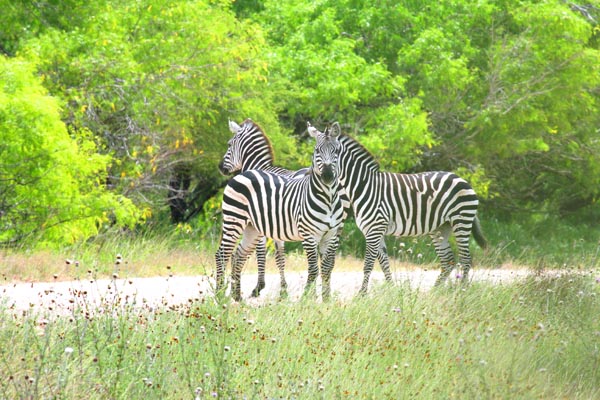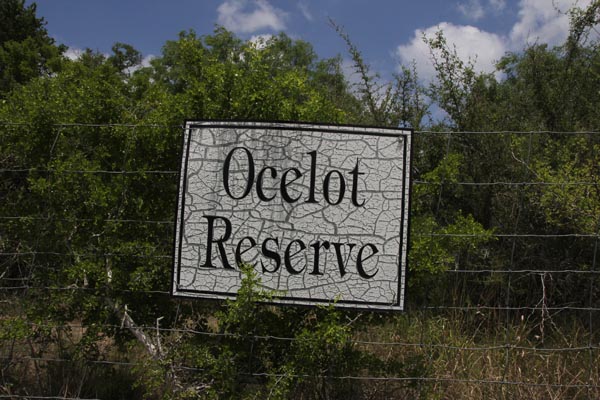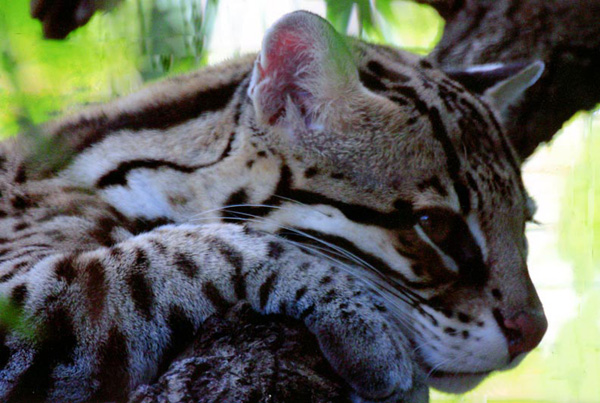For ocelots in Texas, conservation means connecting the dots.
The “dots” are fragments of habitat – primarily thick, dense thornscrub – that the ocelot uses. These habitats are often disconnected from each other, and so ocelots must run a gauntlet of roads and open areas.
Conservancy efforts in ocelot conservation focus on reconnecting these isolated areas.
The U.S. Fish and Wildlife Service has done a remarkable job in working with willing landowners to acquire and protect habitat – the subject of yesterday’s blog.
The agency has protected more than 100,000 acres of good and potential ocelot habitat to date. But more needs to be done, and with tight budgets, the agency can’t protect everything.
The day after my visit to Laguna Atascosa National Wildlife Refuge, I’m looking at how private ranchlands might contribute to ocelot conservation with Sonia Najera, grassland program manager for The Nature Conservancy in Texas.
Najera cut her conservation teeth working on ocelot issues, when as a university student she helped set live traps and use radio telemetry to track cat movements. At times, she spent her days on hands and knees struggling through thick brush to try and get a good signal of a collared ocelot resting nearby.
It’s the same habitat she’s trying to conserve today.
She has become a strong advocate for conserving the Texas brush, the very country that many locals have spent centuries trying to clear.
Today, we’re visiting the Yturria Ranch, a 14,000 acre South Texas property.
Driving through the grassy expanse here is like being on safari. We see white-tailed deer, turkeys, northern bobwhites and javelinas. We even see zebras and waterbuck, far from there African home but now living here thanks to the abundant hunting ranches in the area.

We don’t see ocelots, but they’re here.
“The Yturria Ranch is a lot of different things,” says Najera. “It’s a cattle ranch, it’s a hunting ranch and it’s a wildlife preserve. It also happens to have a breeding population of ocelots. And the owner is very interested in protecting those ocelots.”
Parts of the ranch with the best native thick Tamaulipan thornscrub are protected by conservation easements through The Nature Conservancy and the U.S. Fish and Wildlife Service. A 481-acre tract, never cleared of native brush, serves as an ocelot reserve.
I immediately see them as we drive across the property – thick, brushy stands amidst grassy fields.
When we stop and talk to the ranch foreman, Juan Hernandez, he points across that grass and tells his story. He came here with his uncle in the 1950’s and began working on Yturria. Among his jobs: clearing the very brush that the Conservancy was now protecting.
“All of the ranch was like the ocelot reserve is now,” he says. “During the clearing I’d see ocelots all the time. I’ve even seen mountain lions at times.”

Seeing the Forest for the Brush
Today, part of Najera’s work is something many ranchers would have found difficult to believe: restoring brushy habitat on the ranch.
“Restoring brush after you’ve cleared it? It’s unheard of,” she says. “For a very long time, nobody would have considered bringing back brush. We are not talking about bringing back running mesquite trees or live oak, but divers, native thornscrub. We’re trying to test restoration techniques to see if we could improve ocelot habitat. We recognize that these animals need that habitat, and they need it now. That’s how we can contribute to the effort.”
To that end, the Conservancy has planted 48,000 native brush seedlings to restore cleared pasture back to a Tamaulipan thornscrub forest thicket.
“It will come back on its own, but it takes a really long time,” she says. “We’re trying to accelerate the process by planting in high concentrations using native brush species.”
The seeds for these efforts were collected locally and cultivated to seedlings at the Conservancy’s Southmost Preserve nursery.
Still, ideas about brush can be hard to overcome. In many parts of the country, grassland conservationists try to keep brush out of the prairie. Even in parts of Texas, it is a constant challenge to keep prairie open via fire management and other control methods. But here, the idea is the opposite: to reestablish a diverse brush community.
Najera sees more people recognizing brush as part of Texas’ natural heritage.
“Does every forest have to look like a California redwood grove, or a Rocky Mountain postcard?” she asks. “I don’t think so. The thornscrub is a forest that is vegetatively diverse and supports a variety of birds and mammals. It is such an important habitat not just for ocelots but for many native wildlife species. It’s a spectacular place.”
Najera points out that the U.S. Fish and Wildlife Service is leading the way in collecting data and researching the animals themselves. The agency also has an extensive program of habitat restoration.
The Conservancy and other partners complement this effort in researching restoration techniques and creating habitat corridors.
The Conservancy has a long history of working with landowners, and so can experiment with techniques that meet the landowner’s needs while still helping wildlife.
“Ocelots will travel along a wooded fence row. They’ll use really thick habitat,” she says. “But we also know that they avoid certain areas. Why is that? What is missing here? We believe we can improve these areas, make them more amenable to ocelots, by restoring native thornscrub habitat.”
She has encountered more landowners willing to set aside land like the Yturria Ranch has done. “The more projects we do, the more it allows us to try new ideas and learn from them,” she says.
“The ocelot is an iconic species,” she continues. “It’s so secretive that almost no one has seen one. But I think more people recognize how special it is that we still have places wild enough to support them. They are still out there, sneaking through the thorns. The loss of even one can have dramatic effects on the species’ future. That’s why we need all the research and restoration we can muster.”




i love all cats i would like to donate to your cat sacshoewerey.
I truly appreciate you taking the time and making the effort to visit Laguna Atascosa and write these articles. I am retired and live in Arroyo City, a small resort community, 17 miles from the refuge visitor center where I work as a USFW volunteer. Having lived down here some 50 years ago I have personally witnessed the depletion of suitable Ocelot habitat as well as degradation of the Lower Laguna Madre Bay system the main issue is simply too many people. When I was in high school we’d maybe see 3 or 4 other shallow water boats during a day of flats fishing. Now there are hundreds and the sea grass is suffering from prop scars made when folks do shallow water hole shots. It’s very discouraging.
Thanks again,
Randy Jackson